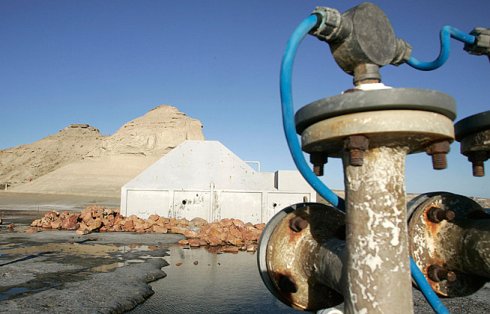Fighting Desertification
For some regions, global warming means less rainfall. Battling desertification will be crucial in the Africa Sahel or parts of China.
The photo shows farmers planting grass to stabilize sand dunes on the edge of the Mu Us Desert in Lingwu, northwest China. (Source: Reuters)
Saving Water on the Farm
Adapting to a hotter climate will be especially tough for the agricultural sector. Making better use of water for irrigation is an important step.
The image shows a worker tending to a newly planted crop on an organic farm in Rancho Santa Fe, California. Organic farmers use plastic tenting covers to keep insects away from young plants and limit evaporation, while they water with more efficient drip irrigation. (Source: Reuters)
3. Securing Water Supplies
Steadily rising water consumption and temperature increases also threaten freshwater supplies. Saltwater desalination provides an alternative for coastal regions.
The picture shows a water desalination plant built offshore Argentina’s Patagonian village of Puerto Piramides. The plant produces about 175,000 liters of desalinated water suitable for urban use and irrigation every day. (Source: Reuters)
4. The Last Choice: Migration
If adaptation fails, migration is often the last choice for those threatened by the impacts of climate change. If resources are stressed, local conflicts often erupt adding another danger to the situation.
br>This aerial view shows an abandoned village in the desert of North Darfur, Sudan in November 2004. People where driven out after attacks by Arab militias. Experts say that a changing climate and scarce resources has been one of the underlying causes of the crisis. (Source: Reuters)
5. Stopping the Sea
The Netherlands is among the countries most at risk to rising sea levels. After thousands lost their lives in a devastating flood in 1953, the country started fortifying seawalls, expanding canals, and constructing dikes, dams, and lock in a large-scale project called the “Delta Works.” The satellite image shows the Dutch region of Zeeland. Dikes are clearly visible. (Source: NASA/GSFC/METI/ERSDAC/JAROS, and U.S./Japan ASTER Science Team)
6. The Delta Works
The American Society of Civil Engineers has named the Dutch “Delta Works” one of the Seven Wonders of the Modern World.
The image shows one of the first storm surge barrier erected in Zeeland shortly after the storm disaster in 1953. The works were finished after almost fifty years in 1997. With over 10,250 miles (16,500 km) of dikes and 300 structures, the project is one of the most extensive engineering projects in the world. (Source: Shutterstock)
7. Protecting the Land
While the “Delta Works” have helped prevent further flood catastrophes in the Netherlands, they wouldn’t be able to resist further rising sea levels. Dams and dikes will have to be made higher and wider.
The Dutch parliament even commissioned a study on whether an artificial island in the shape of a tulip could help protect the most vulnerable parts of the Dutch coastline. The picture shows an artist’s rendition of the project. (Source: Reuters)
Good ideas but how many of these can developing countries, most vulnerable to climate change afford? How much would cutting down emission at source cost developed nations? Share your thoughts.








Interesting points – however I think we should be mindful of making sure that adaptations are cost effective for people in the developing world/ the South – this cheap solar bottle solution from the Philippines is the type of solution/ adaption we should be looking to scale up – http://youtu.be/TYEIT6lLb8A